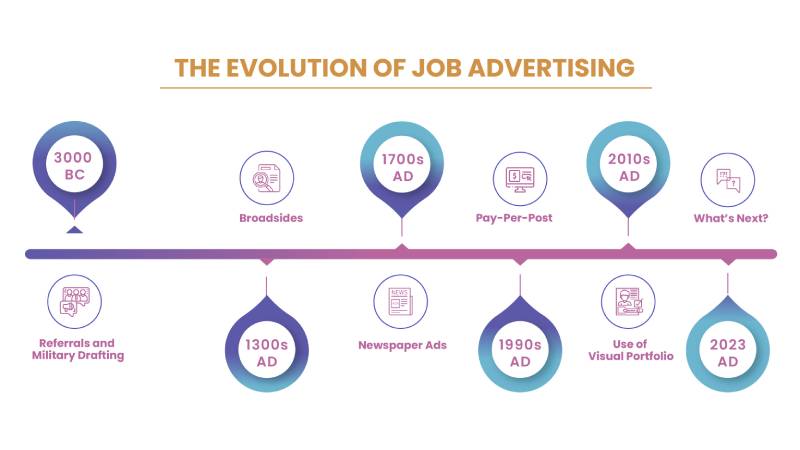Think about it. Recruitment advertising isn’t something new. It’s existed from the time when succinct, brutally honest “Wanted” ads sought sailing crews for hazardous journeys, evolving over time to become the clumsy, pages-long, pathetic mess that we have today.
What went so wrong that we couldn’t have possibly got this bad if we’d tried? Strangely, the answer is technology. While technology usually improves communication and processes, in this case, it has had the opposite effect – and the recruitment process has taken a hit.
Let’s start at the top. Back in 3,000 BC, recruitment worked entirely on referrals (besides drafting into the military services). Generally, if you were looking to hire, someone in your village recommended a relative or neighbor. Then in the 1300s, following the introduction of paper manufacturing, broadsides started advertising jobs in public spaces.
In around 1700, the first “Help Wanted” newspaper ad made its way into people’s homes. These ads formed the backbone of recruitment advertising through the 19th and 20th centuries. Priced per line of type, they brought out the copywriting genius in our budget-crunched predecessors. These ads rarely exceeded 200 words, putting modern-day Twitter woes to shame. The humble newspaper ad exists to this day – even in the sumptuous Hamptons.
Things were largely peaceful till the newspaper ad – as these were all in non-digital format and had to be succinct and to the point. It worked for job seekers as well as employers, who each got the message they needed in the least time needed to comprehend it.
When the internet was born somewhere in the early 1990s, it took over communication entirely, replacing newspapers, phone, and mail. This led to the launch of Monster in 1999, and its near monopoly over an entire era of job advertising. That’s when things really started to change. Content was no longer priced by line, which meant that job ads could be miles long and budget managers wouldn’t bat an eyelid, thanks to fixed pricing. This is also when applicant tracking systems (ATS) made an appearance – ostensibly lending some sense of order to the mounting chaos. The tip of the proverbial iceberg is all it took for non-digital job requisitions to morph into the “requisition deluge of information” that we have today. Somewhere along the line, over 25 years, as the process went online, job requisitions lost their sense of purpose. Sure, the “more information is better” approach may work from the employer’s perspective, but it is clearly not working for the now mobile-enabled job seeker.
The tip of the proverbial iceberg is all it took for non-digital job requisitions to morph into the “requisition deluge of information” that we have today. Somewhere along the line, over 25 years, as the process went online, job requisitions lost their sense of purpose. Sure, the “more information is better” approach may work from the employer’s perspective, but it is clearly not working for the now mobile-enabled job seeker.
So that, as they say, was the beginning of the end. Growing from two or three sentence wanted ads, to job postings long enough to make lawyers weep, there was just no looking back.
The modern job req and CV – a match made in hell?
The average job requisition is now 15 bullets and 500 words long, and, not to be outdone, the average CV is now two to three pages long. Now’s when things get really funny. Truth be told, job requisitions have evolved into what they are today primarily because they are compliance documents – they are meant to ensure that businesses pass regulatory audits supporting fair hiring practices. That’s why they have to list everything that justifies the need to hire – from traceable requisition numbers to skills, experience, and qualifications to diversity requirements, budget needs, and expected outcomes. Funnily, three-page CVs in all probability have evolved in a bid to address 500-word-long job requisitions.
However, most job seekers don’t spend more than 14 seconds reading a job posting before they decide whether or not they want to apply. And with “Easy Apply” and “Multi Apply,” there isn’t even a need to read tens of hundreds of job requisitions – candidates can simply use the same base application to apply for multiple jobs.
On the other side, we have recruiters – who spend an even scarier 6–8 seconds scanning a CV before they decide whether or not a candidate is a match for their vacancy. Bottom line? We’ve got less than 30 seconds to try to connect the dots between a vacancy and the right talent to fill it.
That begs the question, “Are all these lengthy job descriptions doing anyone any good… or are they in fact causing harm?” Back in the day, we had newspaper ads and paper-based resumes. With Millennials and Gen Z entering the workforce, we need everything mobile-optimized – and ironically, this is when we have more than ever to read!
What’s next?
We’re living in times when we have machine learning (ML) and artificial intelligence (AI) to match jobs to candidates, as well as candidates to jobs. Yet, with all the evolution that job requisitions and technology have both undergone, businesses across the globe struggle to find the right talent.
It’s time for job requisitions to be effective. What are your thoughts on how to get there?
Joveo works with companies of all sizes and across industries, globally, to connect recruiters to best-fit talent. Request a demo today and follow us on Twitter and LinkedIn to see how Joveo can help you get the most out of your recruitment advertising.















